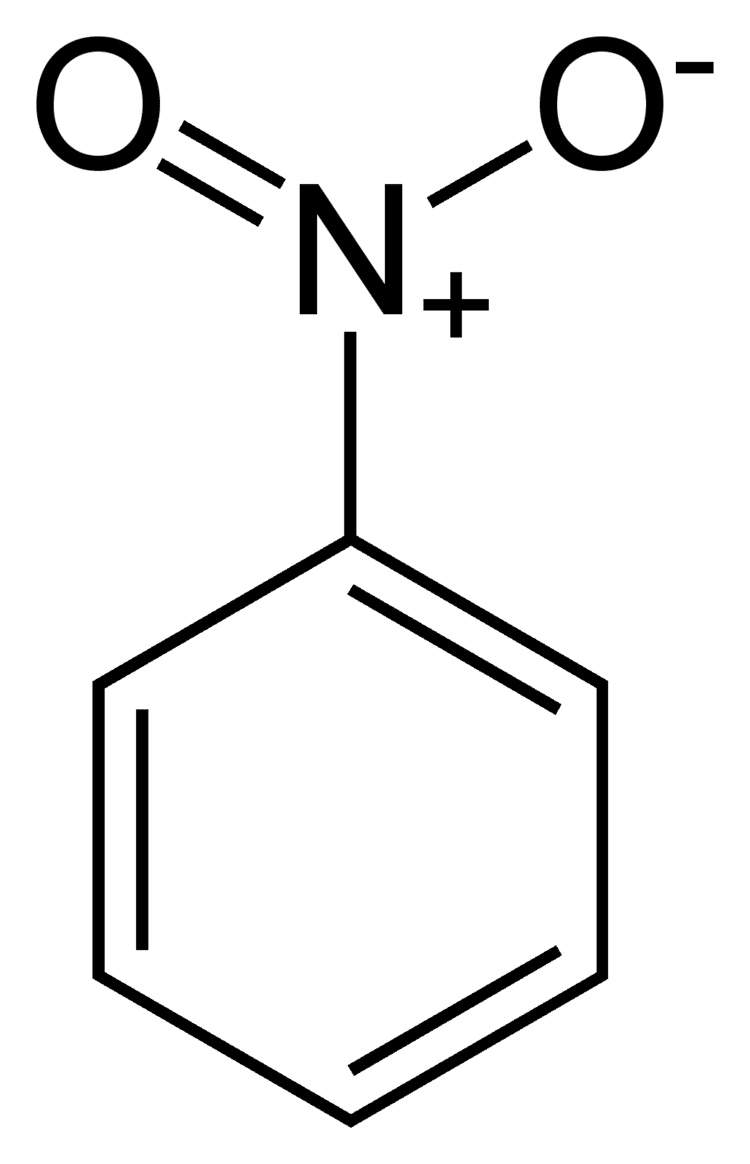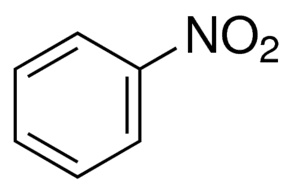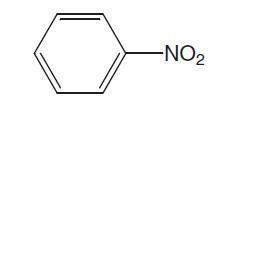Appearance yellowish, oily liquid Boiling point 210.9 °C Density 1.2 g/cm³ | Formula C6H5NO2 Molar mass 123.06 g/mol Melting point 5.7 °C | |
 | ||
Related compounds | ||
Nitrobenzene is an organic compound with the chemical formula C6H5NO2. It is a water-insoluble pale yellow oil with an almond-like odor. It freezes to give greenish-yellow crystals. It is produced on a large scale from benzene as a precursor to aniline. In the laboratory, it is occasionally used as a solvent, especially for electrophilic reagents.
Contents
- Preparation properties uses of nitrobenzene
- Production
- Mechanism of nitration
- Uses
- Specialized applications
- Organic reactions
- Safety
- Popular culture
- References

Preparation properties uses of nitrobenzene
Production

Nitrobenzene is prepared by nitration of benzene with a mixture of concentrated sulfuric acid, water, and nitric acid. This mixture is sometimes called "mixed acid." The production of nitrobenzene is one of the most dangerous processes conducted in the chemical industry because of the exothermicity of the reaction (ΔH = −117 kJ/mol).
World capacity for nitrobenzene in 1985 was about 1.7×106 tonnes.
Mechanism of nitration

The nitration process involves formation of the nitronium ion (NO2+), followed by an electrophilic aromatic substitution reaction of it with benzene. The nitronium ion is generated in situ by the reaction of nitric acid and an acidic dehydration agent, typically sulfuric acid:
HNO3 + H+ ⇌ NO2+ + H2OUses

Approximately 97% of nitrobenzene is consumed in the production of aniline, which is a precursor to rubber chemicals, pesticides, dyes (particularly azo dyes), explosives, and pharmaceuticals.
Specialized applications

Nitrobenzene is also used to mask unpleasant odors in shoe and floor polishes, leather dressings, paint solvents, and other materials. Redistilled, as oil of mirbane, nitrobenzene has been used as an inexpensive perfume for soaps. A significant merchant market for nitrobenzene is its use in the production of the analgesic paracetamol (also known as acetaminophen) (Mannsville 1991). Nitrobenzene is also used in Kerr cells, as it has an unusually large Kerr constant.
Organic reactions

Aside from its conversion to aniline, nitrobenzene is readily converted to related derivatives such as azobenzene, nitrosobenzene, and phenylhydroxylamine. The nitro- group is deactivating, thus substitution tends to occur at the meta-position.
Safety
Nitrobenzene is highly toxic (Threshold Limit Value 5 mg/m3) and readily absorbed through the skin.
Prolonged exposure may cause serious damage to the central nervous system, impair vision, cause liver or kidney damage, anemia and lung irritation. Inhalation of vapors may induce headache, nausea, fatigue, dizziness, cyanosis, weakness in the arms and legs, and in rare cases may be fatal. The oil is readily absorbed through the skin and may increase heart rate, cause convulsions or rarely death. Ingestion may similarly cause headaches, dizziness, nausea, vomiting and gastrointestinal irritation, loss of sensation/use in limbs and also causes internal bleeding.
Nitrobenzene is considered a likely human carcinogen by the United States Environmental Protection Agency, and is classified by the IARC as a Group 2B carcinogen which is "possibly carcinogenic to humans". It has been shown to cause liver, kidney, and thyroid adenomas and carcinomas in rats.
It is classified as an extremely hazardous substance in the United States as defined in Section 302 of the U.S. Emergency Planning and Community Right-to-Know Act (42 U.S.C. 11002), and is subject to strict reporting requirements by facilities which produce, store, or use it in significant quantities.
